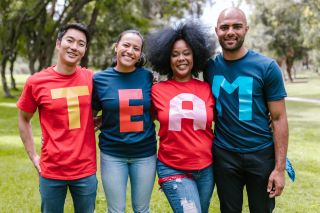Race and Ethnicity
How the “Angry Minority” Trope Gaslights People of Color
Tips for people who combat microaggressions, and their allies.
Updated September 28, 2023 Reviewed by Gary Drevitch
Key points
- When people of color challenge microaggressions, they are often labeled as "angry."
- Difficult conversations about racism often result in people of color being labeled as "angry" or "hostile."
- Women of color and LGBTQ+ people of color may endure more stereotypes due to their intersectional identities.

When people of color have interpersonal conflicts with white people — especially when any verbal disagreement or argument ensues — they are often labeled as “angry” or “hostile." When the conflict involves discussions about race or racism, people of color are often told that they “think about race too much” or that they always “play the race card.”
In fact, when people of color become (rightfully) emotional in discussions about race or racism, they are often told to “fix their tone” or to “relax” — in order to have “a more civilized conversation." When people of color call out microaggressions or challenge other problematic behaviors in others, they are sometimes said to be “escalating situations” or “picking fights," instead of being viewed as advocating for justice or equity.
Related to the “angry minority” trope is the “white victim” trope. When a heated discussion ensues between a person of color (especially a Black person) and a white person, observers (especially other white people) tend to come to the defense of the white person. In these cases, the white person is often deemed a “victim," while the Black person or other person of color is labeled as the “bully” or the “aggressor."
Black women and other women of color may endure even more stereotypes related to others’ perceptions of them as being angry – as a result of their intersectional identities. Because women in general are often stereotyped as being “too emotional” or “hysterical” when they challenge systemic sexism and patriarchy, and because people of color are deemed “angry” or “violent” when they challenge systemic racism, Black women and other women of color are often punished doubly. Kimberelé Crenshaw first coined Intersectionality Theory as a way of describing what it is like for Black women to navigate the intersections of both systemic racism and systemic sexism. More recently, scholars like Jioni Lewis and Helen Neville have identified the gendered racial microaggressions that Black women encounter due to their racial and gender identities. Similarly, LGBTQ+ people of color may endure intersectional microaggressions due to their multiple marginalized identities.
One fundamental problem with the “angry minority” / “white victim” dynamic is how it is weaponized to criminalize or pathologize (and sometimes even violently target) Black people and other people of color. When Black people or other people of color are stereotyped as aggressors, they are presumed to be violent. Such situations result in people calling the police or security guards to “defuse” situations. When authorities arrive, they often immediately view the Black person (or other person of color) as aggressive and accept the white person’s narrative as the truth.
In a less harmful scenario, the authorities (e.g., security guards or police officers) may deescalate the situation but fail to validate the racial dynamic that occurred. In a more harmful situation, the authority figure may view the person of color as being violent or dangerous – resulting in their arrest. And in the most harmful situation, believing a white victim’s narrative over a Black person’s narrative may even result in the Black person’s death.
Gender may also play a role in how angry minority and white victim tropes play out, especially when accusations are made by white women against men of color. For instance, in 2020, both social media and mainstream media began to report instances in which white women accused Black people of crimes they did not commit or of acts that were not crimes at all. In a notable case, a New Yorker named Amy Cooper called 911 and falsely claimed that a Black male birdwatcher named Chris Cooper was threatening her and her dog in Central Park. Some suspect she was sure that by calling the police she, a white woman, would be believed – while he, a Black man, would not be believed.
The intersection of gender and race may also influence how bystanders may empathize with members of some groups over others. For example, imagine a scenario in which a white woman commits a microaggression in a workplace or classroom (e.g., she makes an offensive stereotypical comment about a racial group, or she invalidates a person of color’s lived experiences with racism). If she were to be confronted about the incident by a Black person or person of color, she may visibly cry or shed tears, out of frustration, guilt, or general defensiveness. Because of these tears, many people (especially other white people) may come to her defense, even if it was clear that the white woman initiated the conflict or enacted a harmful microaggression towards the person of color. In some cases, the Black person or other person of color may even be deemed a “bully” for “making” the white woman cry. Mamta Motwani Accapadi described this dynamic in a 2007 article, "When White Women Cry: How White Women's Tears Oppress Women of Color."
The angry minority trope — especially the "angry Black woman" stereotype — became more prevalent with the rise of reality television in the 1990s, as many Black cast members on shows like The Real World or Road Rules were typecast as angry, hostile, mean, or uncooperative — especially when discussions about racism emerged. This trope was repeated in later reality shows like Survivor, The Real Housewives, and RuPaul’s Drag Race – in that Black people and other people of color were portrayed as angry archetypes, despite their diverse and complex histories and identities. Meanwhile, white cast members had been often portrayed as innocent victims who claim to “not see race” and/or deny having any racial biases. In these instances, white people are rewarded for their “colorblindness” instead of being held accountable for their lack of knowledge or awareness of the racial realities of communities of color. Furthermore, people of color are virtually gaslit into believing that maybe they do think about race too much, or that maybe they should not confront problematic behaviors or inequitable racial dynamics.
Microaggression research indicates that many people of color are aware of the “angry minority” trope and may do their best to avoid being stereotyped as such. They may also realize that despite all their accomplishments and unique qualities, that they be representative of their entire racial group – further encouraging them to communicate in “calm” and “non-threatening” ways, in order to avoid any danger or trouble. As a result, many people of color find themselves remaining silent or policing their own emotions – often resulting in internalized feelings like anger, frustration, and sadness. In this way, many people of color learn to internalize oppression instead of learning to externalize oppression.
I share this knowledge with the world because I recently learned that some colleagues in my department have labeled me as being “difficult” or “angry.” Having never raised my voice in anger in any workplace situation – nor having ever said or done anything to convey hostility towards any of my colleagues – I was initially baffled. What is even more confusing is that most people who know me personally can attest that I am pretty laid back; in fact, I am known to get along with people pretty well, often finding humor in most situations and making others laugh.
So why would I be deemed angry?
Upon further reflection, perhaps my colleagues are upset that I regularly talk about racial injustice and inequities – particularly as it may affect our students of color (who comprise 80% of our student population). Perhaps my colleagues feel uncomfortable that I often name the racial disparities that exist in our department and college; for example, while we are a minority-serving institution in one of the most diverse cities in the world, 65% of our faculty members are white. Or perhaps my colleagues need to find any reason to dislike me, to assist in masking their own biases or insecurities.
Whatever the reason, I hope that people learn to own the negative feelings that they may hold – instead of projecting their discomfort or anxiety onto others. I hope people understand that all humans are expected to experience emotional reactions to difficult conversations about race or racism. In fact, scholars like Eduardo Bonilla-Silva have described the notion of “racialized emotions,” or the feelings that are elicited in response to race, often in reaction to interracial interactions and typically similar for people of shared racial groups. For example, Derald Wing Sue writes about how it is common for white people to experience anxiety during difficult dialogues on race, while it is common for people of color to experience sadness or frustration in those same conversations, especially when such difficult dialogues feel consistently disappointing and futile.
The next time you hear a colleague label a person of color as being “angry” or “hostile," I hope you will reflect on how that stereotype came to be and consider whose narrative is believed when such labels are assigned.
I also challenge you to perhaps empathize with a person of color who might be angry or emotional, especially when discussing lived experiences with systemic oppression. Imagine living in a world where you are constantly fighting institutional discrimination and interpersonal microaggressions, above and beyond your everyday work and life responsibilities. Perhaps you might get a little angry, too.




